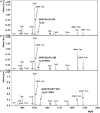The nitrosated bile acid DNA lesion O6-carboxymethylguanine is a substrate for the human DNA repair protein O6-methylguanine-DNA methyltransferase
- PMID: 23335782
- PMCID: PMC3597670
- DOI: 10.1093/nar/gks1476
The nitrosated bile acid DNA lesion O6-carboxymethylguanine is a substrate for the human DNA repair protein O6-methylguanine-DNA methyltransferase
Abstract
The consumption of red meat is a risk factor in human colorectal cancer (CRC). One hypothesis is that red meat facilitates the nitrosation of bile acid conjugates and amino acids, which rapidly convert to DNA-damaging carcinogens. Indeed, the toxic and mutagenic DNA adduct O(6)-carboxymethylguanine (O(6)-CMG) is frequently present in human DNA, increases in abundance in people with high levels of dietary red meat and may therefore be a causative factor in CRC. Previous reports suggested that O(6)-CMG is not a substrate for the human version of the DNA damage reversal protein O(6)-methylguanine-DNA methyltransferase (MGMT), which protects against the genotoxic effects of other O(6)-alkylguanine lesions by removing alkyl groups from the O(6)-position. We now show that synthetic oligodeoxyribonucleotides containing the known MGMT substrate O(6)-methylguanine (O(6)-MeG) or O(6)-CMG effectively inactivate MGMT in vitro (IC50 0.93 and 1.8 nM, respectively). Inactivation involves the removal of the O(6)-alkyl group and its transfer to the active-site cysteine residue of MGMT. O(6)-CMG is therefore an MGMT substrate, and hence MGMT is likely to be a protective factor in CRC under conditions where O(6)-CMG is a potential causative agent.
Figures




References
-
- Cappell MS. Pathophysiology, clinical presentation, and management of colon cancer. Gastroenterol. Clin. North Am. 2008;37:1–24. - PubMed
-
- World Cancer Research Fund/American Institute for Cancer Research. Food, Nutrition, Physical Activity and the Prevention of Cancer: A Global Perspective. Washington, DC: AICR; 2007.
-
- Dahm CC, Keogh RH, Spencer EA, Greenwood DC, Key TJ, Fentiman IS, Shipley MJ, Brunner EJ, Cade JE, Burley VJ, et al. Dietary fiber and colorectal cancer risk: a nested case–control study using food diaries. J. Natl. Cancer Inst. 2010;102:614–616. - PubMed
Publication types
MeSH terms
Substances
Grants and funding
LinkOut - more resources
Full Text Sources
Other Literature Sources
Research Materials

